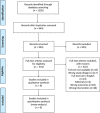Association between insomnia and the incidence of myocardial infarction: A systematic review and meta-analysis
- PMID: 36841256
- PMCID: PMC10106668
- DOI: 10.1002/clc.23984
Association between insomnia and the incidence of myocardial infarction: A systematic review and meta-analysis
Abstract
Background: Insomnia has been closely associated with cardiovascular disease (CVD) including myocardial infarction (MI). Our study aims to assess the eligibility of insomnia as a potential risk factor for MI.
Methods: PubMed, Scopus, and Web of Science were searched using terms; such as "Insomnia" and "MI." Only observational controlled studies with data on the incidence of MI among insomniacs were included. Revman software version 5.4 was used for the analysis.
Results: Our pooled analysis showed a significant association between insomnia and the incidence of MI compared with noninsomniacs (relative risk [RR] = 1.69, 95% confidence interval [CI] = 1.41-2.02, p < .00001). Per sleep duration, we detected the highest association between ≤5 h of sleep, and MI incidence compared to 7-8 h of sleep (RR = 1.56, 95% CI = 1.41-1.73). Disorders of initiating and maintaining sleep were associated with increased MI incidence (RR = 1.13, 95% CI = 1.04-1.23, p = .003). However, subgroup analysis of nonrestorative sleep and daytime dysfunction showed an insignificant association with MI among both groups (RR = 1.06, 95% CI = 0.91-1.23, p = .46). Analysis of age, follow-up duration, sex, and comorbidities showed a significant association in insomniacs.
Conclusion: Insomnia and ≤5 h of sleep are highly associated with increased incidence of MI; an association comparable to that of other MI risk factors and as such, it should be considered as a risk factor for MI and to be incorporated into MI prevention guidelines.
Keywords: STEMI; insomnia; myocardial infarction; sleep disorders.
© 2023 The Authors. Clinical Cardiology published by Wiley Periodicals, LLC.
Conflict of interest statement
The authors declare no conflict of interest.
Figures




Similar articles
-
Effects of a gluten-reduced or gluten-free diet for the primary prevention of cardiovascular disease.Cochrane Database Syst Rev. 2022 Feb 24;2(2):CD013556. doi: 10.1002/14651858.CD013556.pub2. Cochrane Database Syst Rev. 2022. PMID: 35199850 Free PMC article.
-
Systemic pharmacological treatments for chronic plaque psoriasis: a network meta-analysis.Cochrane Database Syst Rev. 2017 Dec 22;12(12):CD011535. doi: 10.1002/14651858.CD011535.pub2. Cochrane Database Syst Rev. 2017. Update in: Cochrane Database Syst Rev. 2020 Jan 9;1:CD011535. doi: 10.1002/14651858.CD011535.pub3. PMID: 29271481 Free PMC article. Updated.
-
Systemic pharmacological treatments for chronic plaque psoriasis: a network meta-analysis.Cochrane Database Syst Rev. 2021 Apr 19;4(4):CD011535. doi: 10.1002/14651858.CD011535.pub4. Cochrane Database Syst Rev. 2021. Update in: Cochrane Database Syst Rev. 2022 May 23;5:CD011535. doi: 10.1002/14651858.CD011535.pub5. PMID: 33871055 Free PMC article. Updated.
-
Antidepressants for insomnia in adults.Cochrane Database Syst Rev. 2018 May 14;5(5):CD010753. doi: 10.1002/14651858.CD010753.pub2. Cochrane Database Syst Rev. 2018. PMID: 29761479 Free PMC article.
-
Sertindole for schizophrenia.Cochrane Database Syst Rev. 2005 Jul 20;2005(3):CD001715. doi: 10.1002/14651858.CD001715.pub2. Cochrane Database Syst Rev. 2005. PMID: 16034864 Free PMC article.
Cited by
-
Neurexan Prescription Is Associated with Lower Risk of Sleep Disorder Recurrence and Depression Prevalence as Compared to Z-Drugs and Benzodiazepines: A Retrospective Database Analysis in Germany.Healthcare (Basel). 2024 Jul 16;12(14):1413. doi: 10.3390/healthcare12141413. Healthcare (Basel). 2024. PMID: 39057556 Free PMC article.
-
Impact of Gender on Insomnia.Brain Sci. 2023 Mar 12;13(3):480. doi: 10.3390/brainsci13030480. Brain Sci. 2023. PMID: 36979290 Free PMC article.
-
Trajectories of Sleep Over Midlife and Incident Cardiovascular Disease Events in the Study of Women's Health Across the Nation.Circulation. 2024 Feb 13;149(7):545-555. doi: 10.1161/CIRCULATIONAHA.123.066491. Epub 2024 Jan 29. Circulation. 2024. PMID: 38284249 Free PMC article.
-
Associations between insomnia and cardiovascular diseases: a meta-review and meta-analysis of observational and Mendelian randomization studies.J Clin Sleep Med. 2024 Dec 1;20(12):1975-1984. doi: 10.5664/jcsm.11326. J Clin Sleep Med. 2024. PMID: 39167428
-
New Perspectives on Treatment of Depression in Coronary Heart Disease.Psychosom Med. 2023 Jul-Aug 01;85(6):474-478. doi: 10.1097/PSY.0000000000001219. Epub 2023 May 26. Psychosom Med. 2023. PMID: 37234020 Free PMC article.
References
-
- Kaur H, Spurling BC, Bollu PC. Chronic insomnia. StatPearls [Internet]. StatPearls Publishing; 2022. https://www.ncbi.nlm.nih.gov/books/NBK526136/ - PubMed
Publication types
MeSH terms
LinkOut - more resources
Full Text Sources
Medical

